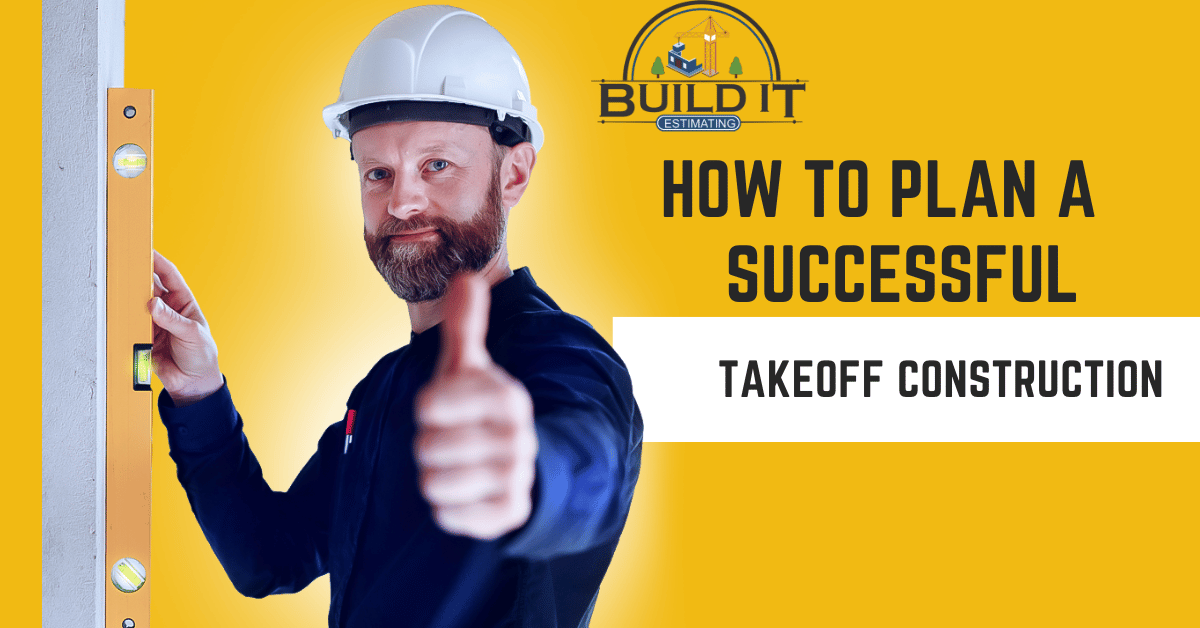Planning a successful construction takeoff is a critical phase in the building process, ensuring that all necessary materials, labor, and costs are accurately estimated and accounted for. A precise takeoff can mean the difference between a profitable project and one that runs over budget and behind schedule. This comprehensive guide covers the key aspects of planning a successful takeoff construction, from understanding its purpose to leveraging the latest technology and best practices.
Understanding Construction Takeoff
Definition and Purpose
Construction takeoff, also known as material takeoff (MTO), is the process of estimating the quantities of materials and labor needed for a construction project. This detailed list includes everything from the number of bricks to the amount of concrete, steel, and other materials required to complete the project. The primary purpose of a construction takeoff is to provide accurate data for cost estimation and budgeting, ensuring that the project can be completed efficiently and within financial constraints.
Types of Construction Takeoffs
There are various types of construction takeoffs, each serving a specific purpose. The most common types include:
- Manual Takeoff: Traditionally done using blueprints and physical measurements, manual takeoff involves counting and measuring each item required for the project.
- Digital Takeoff: Utilizes software and digital plans to automate the counting and measuring process, increasing accuracy and efficiency.
- Quantity Takeoff: Focuses on quantifying the materials needed, such as the volume of concrete or the number of steel beams.
- Labor Takeoff: Estimates the amount of labor required, including the number of workers and hours needed for each phase of the project.
Essential Steps for Planning a Successful Takeoff
Initial Project Assessment
Before starting the takeoff process, it’s crucial to conduct an initial assessment of the project. This includes reviewing the project’s plans and specifications, understanding the scope of work, and identifying any unique challenges or requirements. A thorough assessment sets the foundation for an accurate and comprehensive takeoff.
Gathering Necessary Documentation
Collect all relevant documentation, including architectural drawings, structural plans, and specifications. Ensure that you have the most up-to-date versions of these documents, as changes and revisions can significantly impact the takeoff process. Accurate documentation is essential for precise measurements and estimates.
Creating a Detailed Scope of Work
A detailed scope of work outlines the specific tasks and activities required to complete the project. This includes defining the project’s objectives, deliverables, and timelines. A clear scope of work helps to ensure that all aspects of the project are considered during the takeoff process, reducing the risk of omissions and errors.
Choosing the Right Tools and Software
Selecting the appropriate tools and software for your takeoff process can greatly enhance accuracy and efficiency. Digital takeoff software, for example, can automate many aspects of the process, reducing the likelihood of human error. Evaluate different tools and platforms to find the best fit for your project needs.
Key Components of a Construction Takeoff
Quantity Takeoff
The quantity takeoff involves measuring and counting the materials needed for the project. This includes everything from the number of bricks and tiles to the volume of concrete and steel. Accurate quantity takeoff is critical for developing a reliable cost estimate and ensuring that materials are ordered in the correct quantities.
Material Takeoff
Material takeoff focuses specifically on identifying and quantifying the materials required for the project. This step includes creating a detailed list of all materials, their specifications, and quantities. Material takeoff helps to ensure that all necessary materials are accounted for and that there are no shortages or excesses during the construction phase.
Labor Takeoff
Labor takeoff estimates the amount of labor required for the project. This includes calculating the number of workers, their skill levels, and the hours needed for each task. Accurate labor takeoff helps in planning the workforce and scheduling, ensuring that the project progresses smoothly and on time.
Equipment and Overhead Costs
In addition to materials and labor, a comprehensive takeoff must include equipment and overhead costs. This involves estimating the cost of machinery, tools, and other equipment needed for the project, as well as indirect costs such as administrative expenses, permits, and insurance. Including these costs ensures a complete and accurate project budget.
Accuracy in Construction Takeoff
Importance of Precision
Precision is paramount in construction takeoff. Inaccurate estimates can lead to cost overruns, delays, and resource shortages, all of which can negatively impact the project. Ensuring that measurements and calculations are precise helps to mitigate these risks and contributes to the overall success of the project.
Common Errors and How to Avoid Them
Common errors in construction takeoff include misreading plans, incorrect measurements, and overlooking critical details. To avoid these mistakes, double-check measurements, use reliable tools and software, and ensure thorough review and validation of the takeoff. Regularly updating and verifying documentation can also prevent errors.
Verification and Validation Techniques
Verification and validation techniques involve cross-checking the takeoff data against the project plans and specifications. This can include peer reviews, using checklists, and conducting spot checks. Implementing these techniques helps to identify and correct errors before they impact the project.
Using Technology in Construction Takeoff
Benefits of Digital Takeoff Software
Digital takeoff software offers numerous benefits, including increased accuracy, efficiency, and the ability to handle complex calculations and measurements quickly. These tools can also integrate with other project management and estimation software, streamlining the entire construction planning process.
Popular Takeoff Tools and Platforms
Several digital takeoff tools and platforms are popular in the construction industry, including:
- Bluebeam Revu: Known for its comprehensive set of measurement and markup tools.
- PlanSwift: Offers a user-friendly interface and powerful takeoff capabilities.
- ProEst: Combines takeoff and estimating features for seamless project planning.
- On-Screen Takeoff (OST): A versatile tool that supports both 2D and 3D takeoffs.
Collaborating with Stakeholders
Importance of Communication
Effective communication with stakeholders is crucial for a successful takeoff. This includes regular updates and discussions with project managers, engineers, suppliers, and contractors. Clear communication ensures that everyone is aligned and that any issues or changes are promptly addressed.
Coordinating with Suppliers and Contractors
Coordinating with suppliers and contractors helps to ensure that materials and labor are available when needed. Establishing strong relationships and maintaining open lines of communication can prevent delays and ensure that the project stays on track.
Involving Project Managers and Engineers
Involving project managers and engineers in the takeoff process ensures that all technical aspects and project requirements are considered. Their expertise can provide valuable insights and help to identify potential issues early in the planning stage.
Case Study: Successful Takeoff in a Commercial Project
Project Overview
This section presents a detailed case study of a successful construction takeoff in a commercial project. The project involved the construction of a multi-story office building, requiring precise planning and coordination.
Steps Taken for Accurate Takeoff
The project team conducted a thorough initial assessment, gathered all necessary documentation, and used advanced digital takeoff software. They involved all relevant stakeholders and implemented robust verification techniques to ensure accuracy.
Outcomes and Lessons Learned
The successful takeoff resulted in accurate cost estimates, timely procurement of materials, and efficient project execution. Lessons learned include the importance of technology, stakeholder collaboration, and continuous improvement in takeoff processes.
Challenges in Construction Takeoff
Dealing with Incomplete or Inaccurate Plans
Incomplete or inaccurate plans can pose significant challenges in the takeoff process. To mitigate this, ensure regular updates and clarifications with the design team. Use best practices in document management to keep track of changes and revisions.
Managing Changes and Revisions
Changes and revisions are inevitable in construction projects. Implementing a robust change management process helps to address these effectively. Keep all stakeholders informed of changes and ensure that takeoff data is updated accordingly.
Balancing Time and Cost Constraints
Balancing time and cost constraints requires efficient planning and resource management. Prioritize tasks, use reliable estimation methods, and continuously monitor project progress to ensure that timelines and budgets are adhered to.
Best Practices for a Successful Takeoff
Continuous Improvement and Training
Continuous improvement and training are essential for maintaining high standards in construction takeoff. Invest in regular training for staff, stay updated with industry trends, and implement best practices to enhance accuracy and efficiency.
Regular Review and Updates
Regularly review and update takeoff data and documentation to reflect any changes or new information. This ensures that the project plan remains accurate and reliable throughout the construction process.
Leveraging Industry Standards and Guidelines
Adhering to industry standards and guidelines helps to ensure consistency and quality in the takeoff process. Use established frameworks and best practices to guide your takeoff planning and execution.
Future Trends in Construction Takeoff
Integration with Building Information Modeling (BIM)
The integration of takeoff processes with Building Information Modeling (BIM) is a growing trend. BIM provides a comprehensive and collaborative approach to construction planning, enhancing accuracy and efficiency in takeoff.
Advancements in Takeoff Software
Advancements in takeoff software continue to revolutionize the construction industry. New features and capabilities, such as 3D modeling and automated measurements, are making the takeoff process more precise and efficient.
Impact of Artificial Intelligence and Machine Learning
Artificial intelligence (AI) and machine learning are increasingly being applied to construction takeoff. These technologies can analyze large datasets, identify patterns, and make predictions, further enhancing the accuracy and efficiency of takeoff processes.
FAQs
What is the primary purpose of a construction takeoff? The primary purpose of a construction takeoff is to estimate the quantities of materials, labor, and costs needed for a construction project, ensuring accurate budgeting and efficient project planning.
How can digital takeoff software improve the takeoff process? Digital takeoff software can improve accuracy, efficiency, and speed in the takeoff process by automating measurements and calculations, reducing human error, and integrating with other project management tools.
What are the common errors in construction takeoff and how can they be avoided? Common errors in construction takeoff include incorrect measurements and misreading plans. These can be avoided by double-checking measurements, using reliable tools and software, and implementing verification techniques.
Why is communication with stakeholders important in construction takeoff? Communication with stakeholders ensures that everyone is aligned, issues are promptly addressed, and that materials and labor are coordinated efficiently, preventing delays and ensuring project success.
How does integration with BIM benefit the takeoff process? Integration with Building Information Modeling (BIM) enhances the takeoff process by providing a comprehensive and collaborative approach to construction planning, improving accuracy and efficiency.
What future trends are expected in construction takeoff? Future trends in construction takeoff include advancements in takeoff software, integration with BIM, and the application of artificial intelligence and machine learning to enhance accuracy and efficiency.
Conclusion
Planning a successful construction takeoff is a crucial step in ensuring the smooth execution and financial success of a building project. By understanding the key components, leveraging technology, and implementing best practices, project managers can achieve accurate estimates and efficient resource management. Continuous improvement, effective communication, and staying updated with industry trends will further enhance the takeoff process, contributing to the overall success of construction projects.

